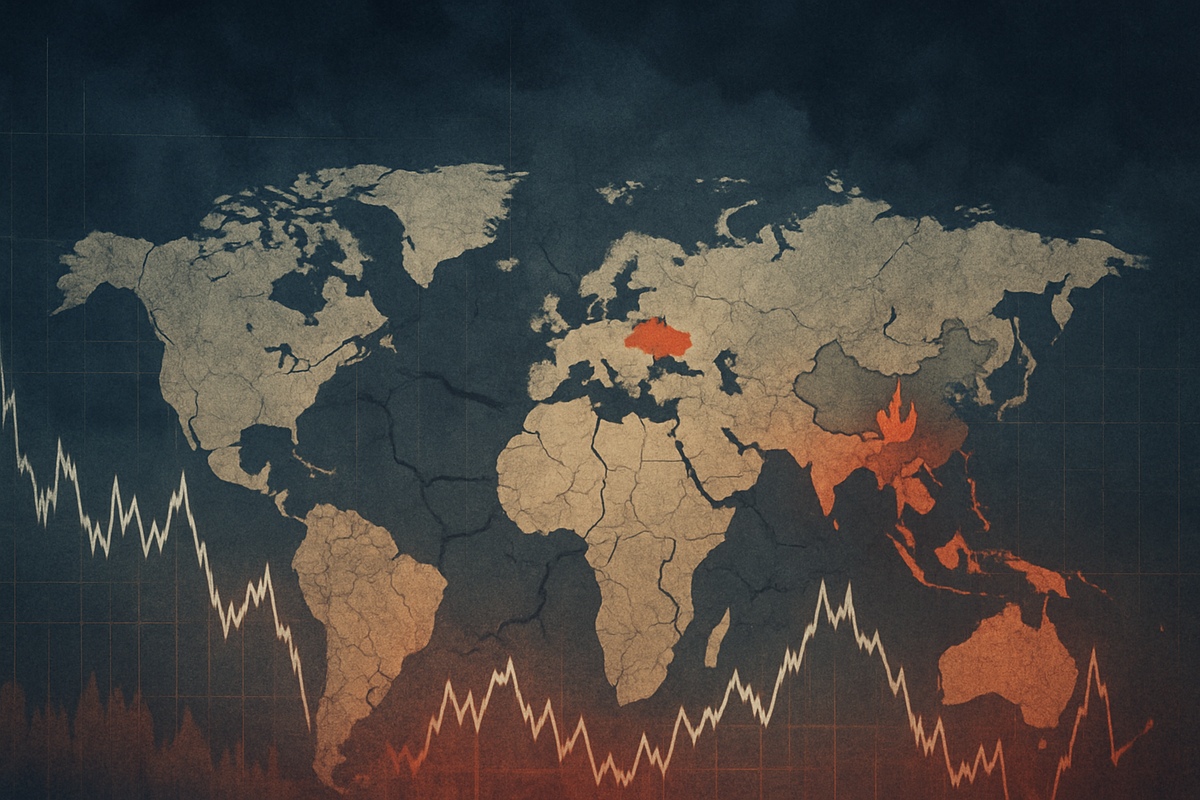
A potent cocktail of escalating geopolitical tensions, including persistent conflicts in Ukraine and the Middle East, combined with a renewed focus on tariffs in the U.S. political landscape, is sending ripples of uncertainty and volatility across global stock markets. This confluence of events is significantly impacting cross-border trade, investment flows, and the pricing of key assets, forcing investors and businesses to navigate an increasingly complex and unpredictable global economic environment. The immediate implications are a heightened sense of risk aversion, disrupted supply chains, and a re-evaluation of international economic partnerships.
The current climate suggests a period of sustained market turbulence as the world grapples with the economic fallout from these multifaceted challenges. From the boardrooms of multinational corporations to the portfolios of individual investors, the effects are being felt, prompting a cautious approach to future planning and a scramble to adapt to rapidly shifting realities.
A World on Edge: Unpacking the Geopolitical and Economic Shocks
The current state of global markets is largely a reflection of several interconnected and evolving crises. The conflict in Ukraine, which began with Russia's full-scale invasion in February 2022, continues to destabilize Eastern Europe and beyond. This unprovoked aggression led to immediate and severe sanctions against Russia by Western nations, disrupting established trade routes, particularly for energy and agricultural commodities. Key events include the initial invasion, the subsequent imposition of sanctions, the blockade of Black Sea ports, and the ongoing humanitarian crisis. Major players include Russia, Ukraine, NATO member states, and the European Union. Initial market reactions saw a sharp decline in European bank equities (over 20% post-invasion) and negative abnormal returns across global stock markets on the day of the war announcement, alongside a surge in energy and food prices.
Simultaneously, conflicts in the Middle East have flared, particularly with recent military strikes and attacks on shipping in vital waterways. The Red Sea, a critical artery for approximately 12% of global trade, has seen significant disruptions due to attacks on vessels, forcing shipping companies to reroute around the Cape of Good Hope. This adds up to 10 extra days and increased costs to transit times, impacting global supply chains. The Strait of Hormuz, another crucial chokepoint handling 20-30% of global oil, remains a potential flashpoint. Key stakeholders include regional powers, international maritime organizations, and global energy consumers. While broader market reactions have sometimes been short-lived due to the Middle East's relatively small share of global GDP, specific sectors like energy and defense have seen immediate impacts, with oil prices jumping following significant incidents.
Adding another layer of complexity, the U.S. political landscape has seen a renewed emphasis on tariffs. While specific new tariffs have been announced on various goods, the broader rhetoric suggests a potential expansion of protectionist policies. This follows previous tariff implementations, such as those against China, which led to a 12% drop in the U.S. equity market over four days after initial announcements, though some losses were later recovered. These measures are driven by a desire to protect domestic industries and rebalance trade relationships. Key players include the U.S. administration, affected trading partners like China and the EU, and multinational corporations with complex supply chains. The initial market reaction to tariff announcements typically involves global stock markets opening lower, with major retailers heavily reliant on imports often seeing stock price declines. The uncertainty surrounding these policies creates a challenging environment for international trade and investment planning.
Navigating the Crosscurrents: Winners and Losers in a Volatile Market
The current geopolitical and tariff-driven environment is creating a distinct divide between potential winners and losers across various sectors and geographies. Companies with strong domestic focus or those benefiting from increased defense spending are likely to fare better, while those heavily reliant on global supply chains, international trade, or specific commodity imports face significant headwinds.
Potential Winners:
- Defense Contractors: Companies like Lockheed Martin (NYSE: LMT) and Raytheon Technologies (NYSE: RTX) are poised to benefit from increased global defense spending driven by heightened geopolitical tensions. Governments worldwide are re-evaluating their security postures, leading to larger defense budgets and new contracts for advanced weaponry and security systems.
- Domestic Manufacturers: U.S. companies that produce goods domestically, particularly those in industries targeted by tariffs, could see a competitive advantage. As imported goods become more expensive, domestic alternatives become more attractive, potentially boosting sales and market share for companies like General Motors (NYSE: GM) or Ford (NYSE: F) if they can localize their supply chains effectively.
- Energy Producers (Oil & Gas): In times of Middle East instability or disruptions to global oil flows, energy companies, especially those with significant production capabilities outside of conflict zones, tend to see increased revenues. Companies like ExxonMobil (NYSE: XOM) and Chevron (NYSE: CVX) could benefit from higher crude oil prices, although this is often balanced by broader economic slowdowns.
- Logistics and Shipping Companies (with adaptable routes): While Red Sea disruptions are challenging, some larger shipping companies with the capacity to reroute vessels and absorb increased costs, or those specializing in alternative transport methods, might see increased demand for their services, albeit at higher operational costs.
Potential Losers:
- Multinational Corporations with Complex Supply Chains: Companies like Apple (NASDAQ: AAPL), which rely heavily on intricate global supply chains for manufacturing and distribution, face significant challenges. Tariffs increase input costs, and disruptions in key trade routes lead to delays and higher shipping expenses, squeezing profit margins and potentially leading to higher consumer prices.
- Retailers Heavily Reliant on Imports: Major retailers such as Walmart (NYSE: WMT) and Target (NYSE: TGT), which source a substantial portion of their inventory from countries targeted by tariffs, will likely see increased costs. These costs may be passed on to consumers, potentially dampening demand, or absorbed by the companies, impacting profitability.
- European Banks: As seen after the Ukraine invasion, European banks with significant exposure to Russia or Eastern European economies, such as Société Générale (EPA: GLE) or UniCredit (BIT: UCG), experienced substantial declines in equity prices due to concerns about economic stability and profitability prospects in the region.
- E-commerce Companies: Tariffs increase operational costs for e-commerce businesses, potentially leading to higher retail prices and reduced consumer spending. Companies like Amazon (NASDAQ: AMZN), while diversified, could see impacts on their international sales and fulfillment costs.
- Airlines and International Freight Carriers: The closure of Russian airspace and the need for rerouting flights between Europe and Asia significantly increase fuel costs and transit times for airlines like Lufthansa (ETR: LHA) and cargo carriers, impacting their operational efficiency and profitability.
The impact on these companies is not uniform and depends heavily on their specific exposure, adaptability, and the duration of these geopolitical and economic pressures.
Broader Implications: Reshaping Industries and Global Commerce
The current confluence of geopolitical tensions and protectionist trade policies is not merely a series of isolated incidents; it represents a significant inflection point that is reshaping global industries and commerce. These events are accelerating existing trends, creating new challenges, and forcing a fundamental re-evaluation of long-held assumptions about globalization and interconnectedness.
One of the most profound implications is the acceleration of supply chain diversification and reshoring efforts. For years, companies prioritized efficiency and cost-effectiveness, often leading to highly concentrated supply chains in specific regions. The Ukraine conflict, Middle East disruptions, and tariff threats have exposed the fragility of this model. Industries from automotive to electronics are now actively seeking to de-risk by diversifying their sourcing, building redundant supply lines, or even bringing production back to their home countries. This fits into a broader trend of "de-globalization" or "slowbalization," where geopolitical considerations are increasingly outweighing purely economic ones. Companies like Samsung Electronics (KRX: 005930) and Intel (NASDAQ: INTC) are investing heavily in new manufacturing facilities in diverse locations, driven by both government incentives and the imperative for supply chain resilience.
The energy sector faces particularly acute ripple effects. The Ukraine conflict highlighted Europe's reliance on Russian energy, prompting a rapid pivot towards alternative sources and renewable energy investments. Middle East tensions, meanwhile, underscore the persistent volatility of oil and gas markets, reinforcing the need for energy security. This could accelerate the transition to renewables for some nations, while others might double down on securing traditional fossil fuel supplies from politically stable regions. The regulatory landscape is also shifting, with governments increasingly intervening in energy markets through subsidies, price caps, or strategic reserves to mitigate the impact of supply shocks.
Regulatory and policy implications are far-reaching. Tariffs, in particular, invite retaliatory measures, leading to a tit-for-tat trade war that can escalate rapidly. The European Union, China, and other major trading blocs are likely to implement their own countermeasures, further fragmenting global trade rules. This creates a complex web of regulations that multinational corporations must navigate, increasing compliance costs and uncertainty. Historically, such protectionist spirals, like those seen in the 1930s, have led to significant global economic downturns, serving as a cautionary tale for policymakers today. While the current situation is not directly comparable in scale, the underlying mechanisms of trade friction and economic nationalism bear striking similarities.
Furthermore, these events are fostering a re-evaluation of international partnerships and alliances. Nations are increasingly aligning based on shared geopolitical interests rather than purely economic ones. This could lead to the formation of new trade blocs or the strengthening of existing ones, potentially marginalizing countries or companies that find themselves on the wrong side of these new geopolitical divides. The long-term impact could be a more fragmented global economy, characterized by regionalized supply chains and trade agreements, rather than a truly globalized one.
What Comes Next: Navigating the Uncharted Waters
The path forward for global markets is fraught with both challenges and potential opportunities, demanding strategic pivots and adaptive responses from businesses and investors alike. The short-term outlook suggests continued volatility, while the long-term trajectory points towards a more regionalized and resilient, albeit potentially less efficient, global economy.
In the short term, investors should brace for ongoing market fluctuations driven by news cycles related to the conflicts and tariff announcements. Commodity prices, particularly for oil, natural gas, and agricultural products, are likely to remain elevated and volatile. Companies with significant international exposure will continue to face supply chain disruptions and increased operational costs. Strategic pivots will involve immediate efforts to secure alternative suppliers, re-evaluate shipping routes, and potentially adjust pricing strategies to absorb or pass on increased expenses. For investors, a "flight-to-safety" mentality may persist, favoring assets like government bonds, gold, and the U.S. dollar, while defense stocks and certain energy companies might see continued interest.
Looking at the long term, the emphasis will shift towards building greater resilience and reducing dependency on single points of failure. This means a sustained push towards reshoring and nearshoring manufacturing, as well as significant investments in supply chain digitalization and transparency. Companies will need to develop more robust risk management frameworks that account for geopolitical factors alongside traditional economic risks. This could create market opportunities for logistics technology providers, automation companies, and firms specializing in regional manufacturing hubs. For example, companies like Rockwell Automation (NYSE: ROK), which provide industrial automation solutions, could see increased demand as businesses seek to make domestic production more competitive.
Potential scenarios and outcomes vary widely. A de-escalation of conflicts and a softening of protectionist trade policies could lead to a rebound in global trade and investment, though the lessons learned about supply chain vulnerability will likely endure. Conversely, an escalation of conflicts or a full-blown trade war could trigger a more significant global economic slowdown, characterized by higher inflation, reduced consumer spending, and a contraction in international commerce. In such a scenario, companies with strong balance sheets, diversified revenue streams, and a focus on essential goods and services would be better positioned to weather the storm. The emergence of new trade agreements or alliances, bypassing traditional global frameworks, is also a distinct possibility, further fragmenting the global economic landscape.
Conclusion: A New Era of Geopolitical Economics
The current period of geopolitical tensions and renewed tariffs marks a significant turning point for global financial markets and the broader economy. The era of seamless globalization, driven primarily by economic efficiency, appears to be giving way to a more complex landscape where geopolitical considerations, national security, and supply chain resilience are paramount. The immediate impact is undeniable: increased market volatility, disrupted trade flows, and a cautious approach to investment.
Moving forward, the market will be characterized by a heightened awareness of geopolitical risk. Investors should recognize that traditional economic indicators alone may no longer provide a complete picture; understanding the nuances of international relations and trade policy will be crucial. Companies that demonstrate agility in adapting their supply chains, diversifying their their market access, and innovating to reduce dependencies will be best positioned for success. This includes a potential shift towards greater regionalization of economic activity, fostering stronger domestic and regional supply chains at the expense of purely global ones.
What investors should watch for in the coming months includes any signs of de-escalation in the ongoing conflicts, the rhetoric and concrete actions surrounding U.S. trade policy, and the responses from major trading partners. The resilience of global supply chains, the trajectory of inflation, and the adaptability of corporate strategies will be key indicators of how effectively the market is navigating this new era of geopolitical economics. Ultimately, the lasting impact will be a more fragmented, yet potentially more resilient, global economic system, where strategic foresight and adaptability are more valuable than ever.






